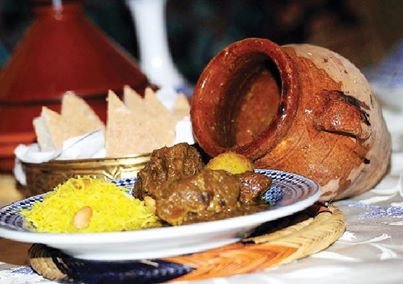Moroccan Tanjia

Tanjia is like the tajine, whose name indicates the pot used for cooking and the cooked food. Tanjia is a jar of pottery that glows from inside, used in ancient times to store and transport oil. Its name today is associated with a dish that is considered one of the most distinguished Moroccan dishes of international renown. The dish of tanjia is associated with the mind of most of those interested in cooking in the city of Marrakesh. This is due to the dedication and creativity of the Marrakesh in preparing this dish. The innovation of tanjia is due to craftsmen who have been creating centuries in various fields of traditional industry in our country. In cities where traditional industry is considered to be an important economic activity such as Fez, Taroudant, Meknès, and Zan ... the craftsmen attend the Tangeriyeh on their weekly night to be ready on the following day, enjoy eating among their friends and family in Kharja to the gardens and orchards near the city, "integrity". Tangerine eaters, which are considered men's specialties, are present in most ancient Moroccan cities.
Preparation of tanjia :
Preparation of the tanjia dish is one of the great rituals. Meat, spices and other ingredients are placed in the jar. The latter is covered with tarpaulin, which is fixed by an iron wire. Tear holes in tarpaulins occur until steam leaks out during cooking. Tangerine is cooked in the oven and cooked as follows: "Mall of the Franchi" ** brings a pile of hot ash called almond.
Dip the tanjia in the center of the amygdala and then be surrounded by a little embers. The success of tanjia cooking is linked to the experience and craftsmanship of the Franchi Mall. Through the smell emitted from it can determine whether the tangerine matured and "fed" and ready to eat.
- The frenchie is the place to heat the traditional bathroom. * "Frankish Mall" is the person who guards the heating of the bathroom by the remnants of wood "carpentry".
Recently most of the bathrooms have become dependent on modern methods to heat them instead of wood and therefore the tanjia cooking in the oven was replaced by other techniques: - Cook the tangerine in a pressure cooker at a very low temperature. - Cook the tangerine in the oven in the middle of a clay pot filled with dough and at a temperature not exceeding 120 degrees. - Finally cook the tanjia in a heavy cooker for a full night on the embers.
To prepare a successful tangerine, you must use mutton pieces rich in gelatin such as: Veal, Veal, Veal, Calf, Veal All the ingredients used to season them must be of high quality such as, cumin, saffron free, sour lemons incense, margarine, olive oil ... To enrich them, some types of chutney are added, such as chickpeas and dry beans, "white cowpea". Dry fruits such as raisins, dates, slices, almonds, cereals such as wheat and rice.
Dip the tanjia in a small amount of water, close well and cook on low heat until the meat is cooked and softened by the gelatin and is characterized by the flavors of spices and the unique taste of ghee
Your post looks so pro @aherbil 👍👍👍
Thank yu dear @joyfulmind
Wow, that is really amazing explanation of Moroccan food. I have tried some Moroccan food before. It has really nice flavor and very heavy. After I ate it, I feel like, I need to have a nap. I am very happy that you join the food challenge @aherbil. I wish you to win this food challenge. Please do not to resteem this post. Greeting from @chanthasam
Yes, regardless of the outcome of the challenge, the important thing is to introduce the culture and diversity of food from one country to another, thank my friend @chanthasam for this interesting challenge
That is very interesting bro. Thanks